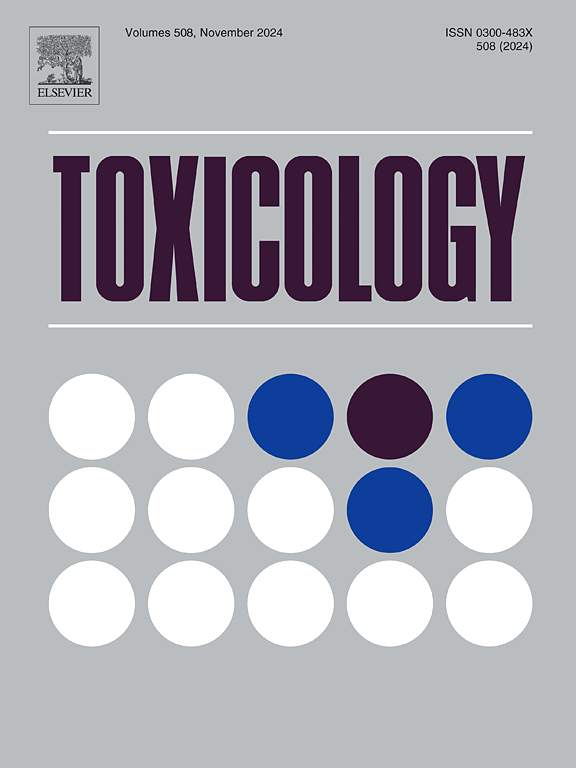MLKL在亚砷酸钠诱导的心肌坏死炎症中激活NLRP3。
IF 4.8
3区 医学
Q1 PHARMACOLOGY & PHARMACY
引用次数: 0
摘要
长期接触砷会增加患一系列心血管疾病的风险。然而,砷暴露导致心肌损伤的机制尚不清楚。我们早期的研究表明,饮用砷污染的水会导致大鼠心肌的严重炎症和坏死损伤。本研究旨在确定混合谱系激酶结构域样蛋白(MLKL)是否在砷诱导的H9C2心肌细胞心肌坏死炎症和MLKL敲除C57BL/6小鼠中触发nod样受体蛋白-3 (NLRP3)激活。我们证明了砷暴露通过激活受体相互作用的丝氨酸/苏氨酸蛋白激酶-3 (RIPK3)/MLKL途径在体内和体外诱导坏死下垂。与我们的假设一致,我们发现necroptosis抑制剂(RIPK1抑制剂necrostatin-1 [Nec-1], RIPK3抑制剂[GSK-872], MLKL抑制剂[NSA])和MLKL基因敲除可以部分保护砷诱导的炎症损伤。此外,这些策略可以下调与NLRP3炎性小体激活相关的关键蛋白的表达,包括NLRP3、Caspase-1和白细胞介素-1β (IL-1β)。综上所述,我们的研究结果表明,MLKL可触发NLRP3炎性体激活,并在砷诱导的心肌坏死炎症中发挥重要作用。本文章由计算机程序翻译,如有差异,请以英文原文为准。
MLKL triggers NLRP3 activation in sodium arsenite-induced myocardial necroinflammation
Prolonged exposure to arsenic elevates the risk of developing a range of cardiovascular disorders. However, the mechanisms underlying myocardial damage from arsenic exposure remain elusive. Our earlier research suggest that drinking arsenic-contaminated water can lead to substantial inflammatory and necrotic injury in the myocardium of rats. This study was to ascertain whether mixed lineage kinase domain-like protein (MLKL) triggers Nod-like receptor protein-3 (NLRP3) activation during arsenic-induced myocardial necroinflammation in H9C2 cardiomyocytes and Mlkl knockout C57BL/6 mice. We demonstrated that arsenic exposure induces necroptosis by activating the receptor-interacting serine/threonine-protein kinase-3 (RIPK3)/MLKL pathway in vivo and in vitro. Consistent with our hypotheses, we found that necroptosis inhibitors (RIPK1 inhibitor necrostatin-1 [Nec-1], RIPK3 inhibitor [GSK-872], MLKL inhibitor [NSA]) and Mlkl genetic knockout can partially protect against arsenic-induced inflammatory damage. Additionally, these strategies can downregulate the expression of key proteins associated with the activation of the NLRP3 inflammasome, including NLRP3, Caspase-1, and interleukin-1β (IL-1β). Taken together, our findings demonstrate that MLKL triggers NLRP3 inflammasome activation and plays an essential role in arsenic-induced myocardial necroinflammation.
求助全文
通过发布文献求助,成功后即可免费获取论文全文。
去求助
来源期刊

Toxicology
医学-毒理学
CiteScore
7.80
自引率
4.40%
发文量
222
审稿时长
23 days
期刊介绍:
Toxicology is an international, peer-reviewed journal that publishes only the highest quality original scientific research and critical reviews describing hypothesis-based investigations into mechanisms of toxicity associated with exposures to xenobiotic chemicals, particularly as it relates to human health. In this respect "mechanisms" is defined on both the macro (e.g. physiological, biological, kinetic, species, sex, etc.) and molecular (genomic, transcriptomic, metabolic, etc.) scale. Emphasis is placed on findings that identify novel hazards and that can be extrapolated to exposures and mechanisms that are relevant to estimating human risk. Toxicology also publishes brief communications, personal commentaries and opinion articles, as well as concise expert reviews on contemporary topics. All research and review articles published in Toxicology are subject to rigorous peer review. Authors are asked to contact the Editor-in-Chief prior to submitting review articles or commentaries for consideration for publication in Toxicology.
 求助内容:
求助内容: 应助结果提醒方式:
应助结果提醒方式:


